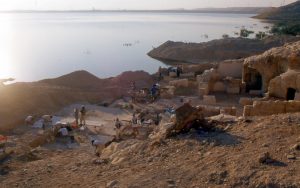The ZAP 2000 project
At the end of 1999 and in the first months of 2000, there were exceptional finds of movable objects, as well as three buildings richly decorated with frescoes and mosaics. Combined with the threat of imminent flooding after the building of a hydroelectric dam on the Euphrates, this led to a cry of alarm for Zeugma from many quarters. The water backed up behind the dam would cover 56 square kilometers and submerge 30 per cent of the ancient city.
The history of the conservation project began in 2000 with only a few months left before the water would flood the part of the city already briefly explored and a strip not yet investigated. The Packard Humanities Institute (PHI) generously provided all the resources needed and inaugurated an international program to save the site.
In coordination with authorities at the Turkish Ministry of Culture, the PHI asked the CCA, Centro di Conservazione Archeologica, to plan an intervention strategy with priority for conservation and a “focused” archaeological inquiry in response to the urgent problems caused by the steady rise of the artificial lake. Thus was born the Zeugma Archaeological Project (ZAP 2000), a large-scale emergency operation involving a topographic survey of the city, protection of structures in situ before submersion, and restoration of everything removed from the site up to that time. Thanks to the PHI project, works discovered during a summer and fall excavation campaign conducted by archaeologists of various nationalities were documented and protected before the flooding. Most of the movable objects and stunning mosaic decorations removed from the site during excavations from 1996 to 2000 were conserved and restored. In the three years following the excavation, the CCA was kept busy conserving 850 m2 of polychrome mosaic pavements, treating a bronze statue of Mars, and restoring 4000 movable objects recovered from the dig.
The primary objective of the program implemented at Zeugma was to transform the guidelines the archaeologists had followed up to that point, enlarging the vision and purpose of the research. With the new treatment strategy, we wanted to expand the interpretation of problems, moving the focus (and interventions) from single objects or mosaics toward a broader panorama to benefit the entire site and the local community. Hence, no more endless small, ad hoc treatments for a single room or a single object, but a general program devised around the themes that reflect conservation thinking today: documentation, protection in situ, and restoration. At the same time, the approach also involves sharing information and training technical personnel, with particular attention to developing local resources so that everything accomplished now can be sustained in the future.
All together, from 2000 to 2004 the Zeugma project involved the CCA in the following programs:
– Conservation in situ of structures and surfaces during excavation in area B, 2000
– Conservation of 850 m2 of mosaic pavements detached from the site, 2001-2004
– Project to set up a site museum at Zeugma, 2001
– Conservation-restoration of a bronze statue of Mars, 2001-2003
– Conservation-restoration of movable objects from the excavation, 2000-2003





















